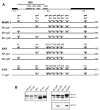Removal of either N-glycan site from the envelope receptor binding domain of Moloney and Friend but not AKV mouse ecotropic gammaretroviruses alters receptor usage
- PMID: 19584017
- PMCID: PMC2732407
- DOI: 10.1016/j.virol.2009.06.015
Removal of either N-glycan site from the envelope receptor binding domain of Moloney and Friend but not AKV mouse ecotropic gammaretroviruses alters receptor usage
Abstract
Three N-linked glycosylation sites were removed from the envelope glycoproteins of Friend, Moloney, and AKV mouse ecotropic gammaretroviruses: gs1 and gs2, in the receptor binding domain; and gs8, in a region implicated in post-binding cell fusion. Mutants were tested for their ability to infect rodent cells expressing 4 CAT-1 receptor variants. Three mutants (Mo-gs1, Mo-gs2, and Fr-gs1) infect NIH 3T3 and rat XC cells, but are severely restricted in Mus dunni cells and Lec8, a Chinese hamster cell line susceptible to ecotropic virus. This restriction is reproduced in ferret cells expressing M. dunni dCAT-1, but not in cells expressing NIH 3T3 mCAT-1. Virus binding assays, pseudotype assays, and the use of glycosylation inhibitors further suggest that restriction is primarily due to receptor polymorphism and, in M. dunni cells, to glycosylation of cellular proteins. Virus envelope glycan size or type does not affect infectivity. Thus, host range variation due to N-glycan deletion is receptor variant-specific, cell-specific, virus type-specific, and glycan site-specific.
Figures





Similar articles
-
Role of receptor polymorphism and glycosylation in syncytium induction and host range variation of ecotropic mouse gammaretroviruses.Retrovirology. 2008 Jan 10;5:2. doi: 10.1186/1742-4690-5-2. Retrovirology. 2008. PMID: 18186934 Free PMC article.
-
Novel host range and cytopathic variant of ecotropic Friend murine leukemia virus.J Virol. 2004 Nov;78(22):12189-97. doi: 10.1128/JVI.78.22.12189-12197.2004. J Virol. 2004. PMID: 15507605 Free PMC article.
-
Generation of novel syncytium-inducing and host range variants of ecotropic moloney murine leukemia virus in Mus spicilegus.J Virol. 2003 May;77(9):5065-72. doi: 10.1128/jvi.77.9.5065-5072.2003. J Virol. 2003. PMID: 12692209 Free PMC article.
-
Murine leukemia viruses with recombinant env genes: a discussion of their role in leukemogenesis.Curr Top Microbiol Immunol. 1983;103:75-108. doi: 10.1007/978-3-642-68943-7_4. Curr Top Microbiol Immunol. 1983. PMID: 6303710 Review. No abstract available.
-
Differentiation and viral involvement in differentiation of transformed mouse and rat erythroid cells.Curr Top Microbiol Immunol. 1981;94-95:143-208. doi: 10.1007/978-3-642-68120-2_4. Curr Top Microbiol Immunol. 1981. PMID: 6273072 Review. No abstract available.
Cited by
-
Reduced vacuolar ATPase protects mice from Friend virus infection - an unintended but instructive effect in Hif-2afl mice.J Cell Sci. 2024 Jun 15;137(12):jcs261893. doi: 10.1242/jcs.261893. Epub 2024 Jun 28. J Cell Sci. 2024. PMID: 38856651 Free PMC article.
-
Glycoproteome in silkworm Bombyx mori and alteration by BmCPV infection.J Proteomics. 2020 Jun 30;222:103802. doi: 10.1016/j.jprot.2020.103802. Epub 2020 Apr 29. J Proteomics. 2020. PMID: 32360640 Free PMC article.
-
Naturally Occurring Polymorphisms of the Mouse Gammaretrovirus Receptors CAT-1 and XPR1 Alter Virus Tropism and Pathogenicity.Adv Virol. 2011;2011:975801. doi: 10.1155/2011/975801. Epub 2011 Oct 23. Adv Virol. 2011. PMID: 22312361 Free PMC article.
-
Mutational analysis and glycosylation sensitivity of restrictive XPR1 gammaretrovirus receptors in six mammalian species.Virology. 2019 Sep;535:154-161. doi: 10.1016/j.virol.2019.07.004. Epub 2019 Jul 3. Virology. 2019. PMID: 31302509 Free PMC article.
-
LCMV glycosylation modulates viral fitness and cell tropism.PLoS One. 2013;8(1):e53273. doi: 10.1371/journal.pone.0053273. Epub 2013 Jan 7. PLoS One. 2013. PMID: 23308183 Free PMC article.
References
-
- Battini JL, Kayman SC, Pinter A, Heard JM, Danos O. Role of N-linked glycosylation in the activity of the Friend murine leukemia virus SU protein receptor-binding domain. Virology. 1994;202:496–499. - PubMed
Publication types
MeSH terms
Substances
Grants and funding
LinkOut - more resources
Full Text Sources
Miscellaneous

